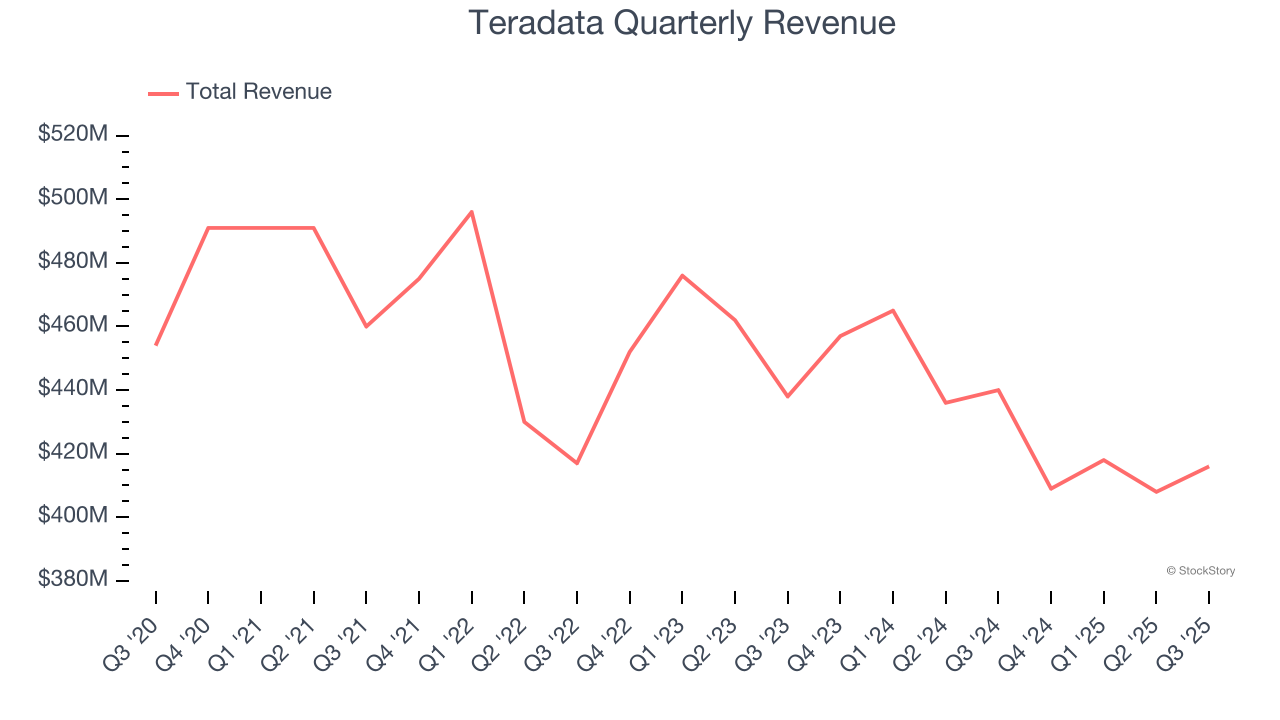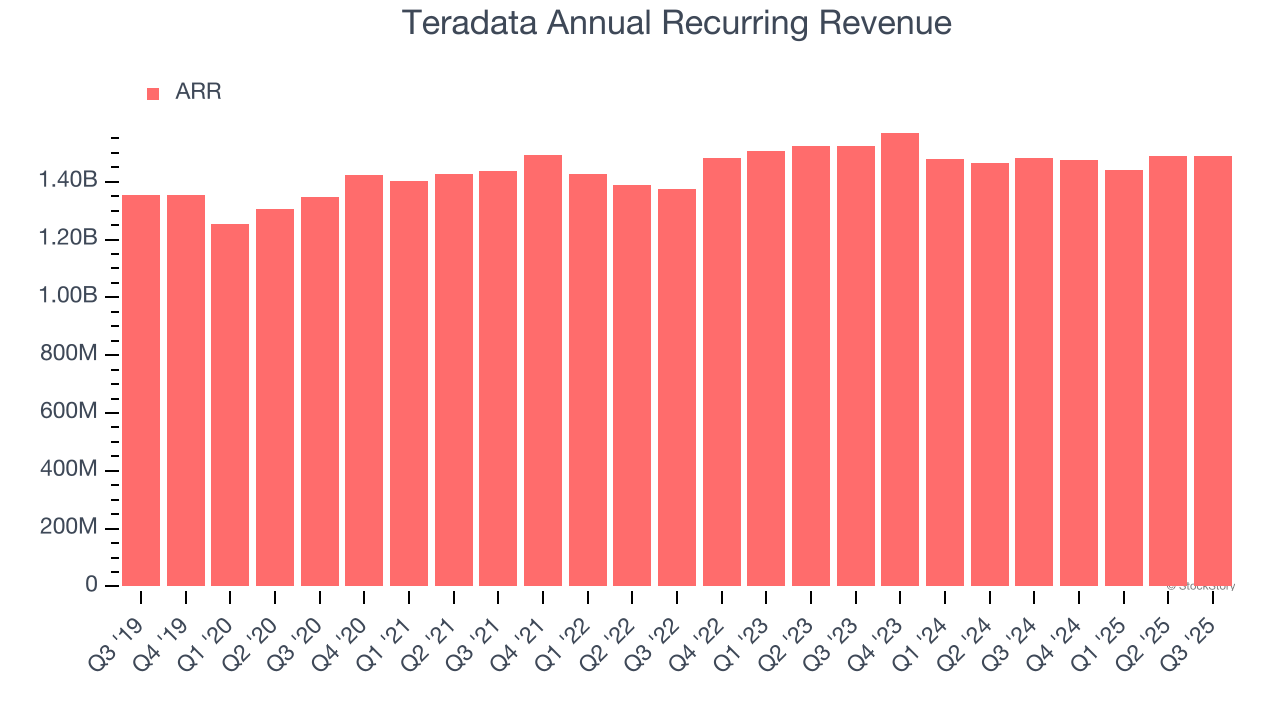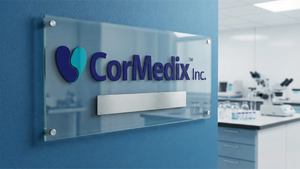
Cloud analytics platform Teradata (NYSE: TDC) beat Wall Street’s revenue expectations in Q3 CY2025, but sales fell by 5.5% year on year to $416 million. On the other hand, next quarter’s revenue guidance of $396.7 million was less impressive, coming in 1.8% below analysts’ estimates. Its non-GAAP profit of $0.72 per share was 34.3% above analysts’ consensus estimates.
Is now the time to buy Teradata? Find out by accessing our full research report, it’s free for active Edge members.
Teradata (TDC) Q3 CY2025 Highlights:
- Revenue: $416 million vs analyst estimates of $406.1 million (5.5% year-on-year decline, 2.4% beat)
- Adjusted EPS: $0.72 vs analyst estimates of $0.54 (34.3% beat)
- Adjusted Operating Income: $98 million vs analyst estimates of $80.2 million (23.6% margin, 22.2% beat)
- Revenue Guidance for Q4 CY2025 is $396.7 million at the midpoint, below analyst estimates of $404 million
- Management raised its full-year Adjusted EPS guidance to $2.40 at the midpoint, a 8.6% increase
- Operating Margin: 14.7%, up from 12.7% in the same quarter last year
- Free Cash Flow Margin: 21.2%, up from 9.6% in the previous quarter
- Annual Recurring Revenue: $1.49 billion vs analyst estimates of $1.47 billion (flat year on year, 1.6% beat)
- Market Capitalization: $2.04 billion
“Q3 marked another quarter of solid execution as we beat our revenue and recurring revenue guidance ranges, as well as delivered non-GAAP earnings per share and free cash flow ahead of expectations. We are affirming our outlook for 2025,” said Steve McMillan, president and CEO, Teradata.
Company Overview
Pioneering data warehousing technology in the 1980s before "big data" was a common term, Teradata (NYSE: TDC) provides cloud-based data analytics and AI platforms that help large enterprises integrate, analyze, and leverage their data across multiple environments.
Revenue Growth
A company’s long-term performance is an indicator of its overall quality. Any business can experience short-term success, but top-performing ones enjoy sustained growth for years. Teradata struggled to consistently generate demand over the last five years as its sales dropped at a 2.1% annual rate. This was below our standards and is a sign of poor business quality.

Long-term growth is the most important, but within software, a half-decade historical view may miss new innovations or demand cycles. Teradata’s recent performance shows its demand remained suppressed as its revenue has declined by 5% annually over the last two years. 
This quarter, Teradata’s revenue fell by 5.5% year on year to $416 million but beat Wall Street’s estimates by 2.4%. Company management is currently guiding for a 3% year-on-year decline in sales next quarter.
Looking further ahead, sell-side analysts expect revenue to decline by 1.1% over the next 12 months. While this projection is better than its two-year trend, it’s hard to get excited about a company that is struggling with demand.
Microsoft, Alphabet, Coca-Cola, Monster Beverage—all began as under-the-radar growth stories riding a massive trend. We’ve identified the next one: a profitable AI semiconductor play Wall Street is still overlooking. Go here for access to our full report.
Annual Recurring Revenue
While reported revenue for a software company can include low-margin items like implementation fees, annual recurring revenue (ARR) is a sum of the next 12 months of contracted revenue purely from software subscriptions, or the high-margin, predictable revenue streams that make SaaS businesses so valuable.
Teradata’s ARR came in at $1.49 billion in Q3, and it averaged 1.6% year-on-year declines over the last four quarters. However, this alternate topline metric outperformed its total sales, which likely means that the recurring portions of the business are growing faster than less predictable, choppier ones such as implementation fees. That could be a good sign for future revenue growth. 
Customer Acquisition Efficiency
The customer acquisition cost (CAC) payback period represents the months required to recover the cost of acquiring a new customer. Essentially, it’s the break-even point for sales and marketing investments. A shorter CAC payback period is ideal, as it implies better returns on investment and business scalability.
Teradata is extremely efficient at acquiring new customers, and its CAC payback period checked in at 19.1 months this quarter. The company’s rapid recovery of its customer acquisition costs means it can attempt to spur growth by increasing its sales and marketing investments.
Key Takeaways from Teradata’s Q3 Results
Revenue and EPS in the quarter beat. We were also impressed by Teradata’s optimistic full-year EPS guidance, which blew past analysts’ expectations. We were also glad its EPS guidance for next quarter exceeded Wall Street’s estimates. Overall, this print had some key positives. The stock traded up 8% to $22.39 immediately after reporting.
Teradata had an encouraging quarter, but one earnings result doesn’t necessarily make the stock a buy. Let’s see if this is a good investment. If you’re making that decision, you should consider the bigger picture of valuation, business qualities, as well as the latest earnings. We cover that in our actionable full research report which you can read here, it’s free for active Edge members.





